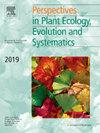法国中部濒危植物蒙大拿山金车(菊科)不相交居群的分类和遗传评价
IF 2.9
3区 环境科学与生态学
Q1 ECOLOGY
Perspectives in Plant Ecology Evolution and Systematics
Pub Date : 2025-04-30
DOI:10.1016/j.ppees.2025.125873
引用次数: 0
摘要
为了优化遗传恢复,不仅需要遗传多样性的数量,还需要群体间的遗传分化。当遗传差异过大时,适应不良和近亲繁殖抑制可能会损害种群的长期进化潜力。山金车是一种走下坡路、自交不亲和、无性繁殖的山地草本植物,在其分布范围内表现出广泛的表型变异。根据核和质体标记以及倍半萜内酯组成对两个亚种(atlantica和montana)进行了描述。在法国中部(卢瓦尔河谷地区),关于不相交的、低海拔的和生态边缘的种群的分类仍然不确定。本文利用4个质体标记和9个多形微卫星标记,定量分析了卢瓦尔河谷河谷河谷地区的A. m.亚种与阿登地区(法国北部、比利时和卢森堡)低海拔地区的A. m.亚种的遗传多样性和结构。蒙大拿。小规模的Val-de-Loire种群保留了与较大的阿登恢复种群相似的遗传多样性,因此它们可以作为局部易位的种子来源,通过源混合考虑到高克隆性导致的兼容配偶数量少。卢瓦尔河谷和阿登地区人群之间的遗传分化表明了距离隔离效应、建立效应和遗传漂变效应。Val-de-Loire种群与Ardennes种群具有相同的系统地理历史和化学型,因此可以将其归因于a.m.a sp。蒙大拿。种群之间和种群内部广泛的化学型差异表明,表型可塑性与现场环境和气候条件有关,但也基于遗传的局部适应。在气候变化和富营养化加剧的背景下,保护这些生态边缘种群显得很重要。本文章由计算机程序翻译,如有差异,请以英文原文为准。
Taxonomic and genetic assessment of disjunct populations of the threatened plant Arnica montana (Asteraceae) from central France
To optimize genetic restoration, not only the amount of genetic diversity is important, but also genetic differentiation among populations. When genetic divergence is too high, maladaptation and outbreeding depression may compromise long-term population evolutionary potential. The declining, self-incompatible, clonally-propagating mountainous herb Arnica montana (Asteraceae) shows wide phenotypic variation through its range. Two subspecies (atlantica and montana) were described based on nuclear and plastid markers and on sesquiterpene lactone composition. Taxonomic uncertainties remain about disjunct, low elevational, and ecologically marginal populations in central France (Val-de-Loire region). We investigated genetic diversity and structure using four plastid markers and nine polymorphic microsatellite markers and quantified helenalin and dihydrohelenalin compounds in flowers, to compare Val-de-Loire populations with low-elevation populations from Ardennes (northern France, Belgium and Luxembourg) ascribed to A. m. subsp. montana. Small Val-de-Loire populations retained genetic diversity similar to the larger restored Ardennes populations, so that they may be used as seed sources for local translocations, with source mixing to take the small number of compatible mates due to high clonality into account. Genetic differentiation between Val-de-Loire and Ardennes populations suggests isolation-by-distance, and founding and genetic drift effects. Val-de-Loire populations share the same phylogeographic history and chemotype as Ardennes populations, and can thus be ascribed to A. m. subsp. montana. The wide chemotypic variation among and within populations suggests phenotypic plasticity related to site environment and climatic conditions, but also genetically-based local adaptation. The preservation of such ecologically marginal populations appear important in a context of climate change and increased eutrophication.
求助全文
通过发布文献求助,成功后即可免费获取论文全文。
去求助
来源期刊
CiteScore
6.50
自引率
0.00%
发文量
28
审稿时长
67 days
期刊介绍:
Perspectives in Plant Ecology, Evolution and Systematics (PPEES) publishes outstanding and thought-provoking articles of general interest to an international readership in the fields of plant ecology, evolution and systematics. Of particular interest are longer, in-depth articles that provide a broad understanding of key topics in the field. There are six issues per year.
The following types of article will be considered:
Full length reviews
Essay reviews
Longer research articles
Meta-analyses
Foundational methodological or empirical papers from large consortia or long-term ecological research sites (LTER).

 求助内容:
求助内容: 应助结果提醒方式:
应助结果提醒方式:


